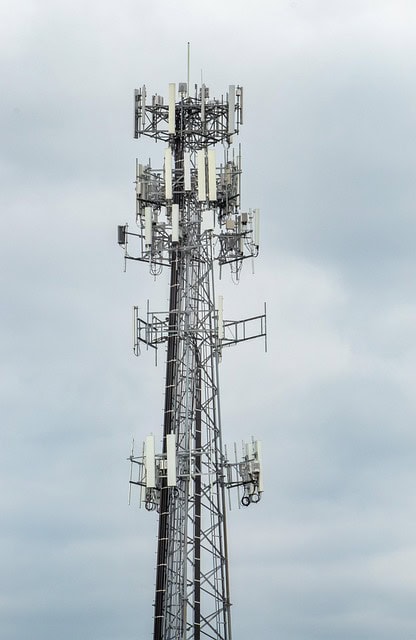EHS Disease- Complete Guide: Symptoms, Causes, and Solutions
*The information on EMF Academy is for educational purposes only and is not a substitute for professional medical advice. Please review our full Medical Disclaimer for more details. This post may contain affiliate links. Please see my disclosure to learn more.
It's a fact that our world is more connected than it has ever been before. Wi-Fi is everywhere, cell towers continue to pop up everywhere (including 5G towers), and more and more devices are becoming “smart” versions of themselves.
For some people, this constant exposure to the EMF radiation emitted from this technology isn't just an inconvenience or a long-term health concern; it's a daily source of real, physical discomfort.
What Is EHS?
This condition is called Electromagnetic Hypersensitivity (or EHS), sometimes also referred to as Electrosensitivity (ES), EHS disease, or EHS syndrome.
Essentially, EHS is a sensitivity to the various kinds of EMF (Electromagnetic Field) radiation from modern devices such as Wi-Fi, cell phones, and even your home wiring.
For individuals who have EHS, the radiation emitted from these devices can trigger a variety of symptoms such as headaches, fatigue, dizziness, and skin irritation.
I've been researching and writing about EMF radiation and how it affects our health for years. In that time I've had the opportunity to talk to countless individuals about how electromagnetic hypersensitivity (EHS) has affected their lives.
In this guide, I'm going to walk you through everything you need to know about EHS, including: what it is, how to recognize it, and perhaps most importantly, what steps you can take to reduce your exposure and hopefully feel better.
Symptoms of EHS
If you're reading this article, there is a pretty good chance that you, or someone that you know, are experiencing some symptoms when you're spending a lot of time around technology.
Maybe it's a headache that re-occurs when you're on your phone, or a feeling of fatigue or loss of concentration when you're at your computer, or maybe your skin is tingling.
These are all common signs of Electromagnetic Hypersensitivity (EHS). While the symptoms can vary between cases, here are some of the most commonly reported symptoms:

- Headaches or migraines
- Fatigue, even after a full night’s sleep
- Dizziness or lightheadedness
- Sleep disturbances, like insomnia or restless sleep
- Skin issues, such as rashes, redness, or a tingling sensation
- Cognitive problems, including difficulty concentrating or memory lapses
The severity of these symptoms can also vary. For some people, these symptoms might be fairly mild, for others, they can be quite debilitating.
When these symptoms flare up, it can make it difficult to work, socialize, or even focus at all.
The hard part about EHS is that the symptoms can overlap with other conditions, such as chronic fatigue, fibromyalgia, or a variety of other health conditions.
That is why it is so important to pay close attention to when and where your symptoms are occurring.
Do you notice symptoms when you're close to your home Wi-Fi router? Do you get a headache when you're on your cell phone for too long?
If you are experiencing symptoms as I talked about above, I'd highly encourage you to start tracking them.
Just keep a simple journal somewhere convenient, and write down what you're feeling, and the environment in which you're feeling it.
Over time this will become your best tool to understanding not only whether or not you have EHS, but how specifically you can reduce your symptoms.
Causes of EHS

So, what exactly is it that is causing all of these symptoms?
In short, the answer is EMF (Electromagnetic Field) radiation, an invisible energy emitted by many of the devices and technologies we use today.
There are three kinds of EMF radiation:
- Magnetic Fields
- Electric Fields
- Radio Frequency
When we're talking about sending data wirelessly, like cell phones, Wi-Fi, Bluetooth, etc., we're usually referring to Radio Frequency (or RF) radiation.
The primary sources of EMF radiation that seem to most commonly trigger EHS symptoms include:
- Wi-Fi routers: These devices constantly emit radiofrequency (RF) radiation to keep you connected. (Read my full article)
- Cell phones and towers: Your phone is a major source of RF radiation, especially when making calls. (Read my full article)
- Smart meters: This modern version of utility meters, often installed on homes, communicate wirelessly and can emit high levels of RF radiation. (Read my full article)
- Dirty electricity: This is the “noise” created by modern electronics that disrupts the smooth flow of electricity in your home’s wiring. (Read my full article)
- Fluorescent lighting (CFLs): These bulbs are notorious for creating dirty electricity and emitting UV radiation. (Read my full article)
Now, although EHS is still being studied, early research suggests that prolonged exposure to EMF radiation may disrupt cellular function in some sensitive individuals.
One example of this is that some studies have found that EMF radiation can interfere with the calcium channels in cells, which play an important role in nerve and muscle function.
This could be a contributing reason why people with EHS experience some of the symptoms we talked about above, such as headaches, fatigue, or tingling.
How to Diagnose EHS
If you think that you might have EHS, the first thing you need to do is start tracking your symptoms and exposures.
This is the best way to begin understanding whether you have EHS: to systematically identify patterns between EMF radiation exposure, and symptoms you experience.
Here is a good way to do this:
Step 1. Keep a symptom Journal

Start by writing down your symptoms when you notice them appear, such as:
- What you're feeling (headache, fatigue, dizziness)
- When it occurred (while on your cell phone, sitting near a Wi-Fi router, etc.)
- How severe it was (mild, moderate, debilitating)
Over time, this journal will allow you to spot trends and narrow in on what could be causing your symptoms to appear.
Step 2. Reduce your EMF Exposure
Once you've started tracking your symptoms, the next thing I would suggest is that you take some steps to reduce your EMF exposure.
I have a ton of articles and tips on this topic on EMF Academy, but here are a few examples of things you can try.
- Turn off your Wi-Fi at night: This is one of the easiest things you can do to reduce your exposure while you're sleeping.
- Use air tube headphones instead of wireless: Wireless headphones and earbuds (like Airpods) produce a large amount of EMF radiation close to your brain. Air tube headphones allow you to use your devices (including making calls) without having your phone or wireless headphones near your brain.
- Filter Dirty Electricity – Use dirty electricity filters to reduce EMF pollution from your home’s electrical wiring.
I’ve written a detailed guide on How to Eliminate EMFs in the Bedroom, which is a great place to start.
Step 3: Test Your Environment

If you’re serious about diagnosing EHS, I would suggest investing in an EMF meter (read my full guide on how to pick the right one for you).
I personally like to use the Trifield TF2, which measures electric, magnetic, and RF field radiation (all three kinds of EMF radiation).
It’s user-friendly and gives you a clear picture of where the hotspots are in your home.
I wrote up a helpful guide that talks about what “high EMF readings” are, as well as how to test for these readings with your EMF meter.
Step 4: Consult a Specialist
If your symptoms persist, it’s a good idea to consult a healthcare provider familiar with EHS.
Bring your symptom journal and EMF readings to the appointment. While not all doctors are knowledgeable about EHS, there are specialists that can help.
Related Questions
Is EHS a recognized medical condition?
Yes, Electromagnetic Hypersensitivity (EHS) is acknowledged by the World Health Organization (WHO) as a real condition with documented symptoms.
However, it’s not yet classified as a formal medical diagnosis.
This means that while many people experience real symptoms, the medical community is still working to fully understand the mechanisms behind EHS.
Are children more susceptible to EHS?
Children may be more vulnerable to EHS due to their developing bodies and thinner skulls, which can absorb more EMF radiation.
Studies, like this one from the National Institute of Environmental Health Sciences (NIEHS), suggest that prolonged exposure to EMFs during childhood could have long-term health effects.
That’s why it’s especially important to limit their exposure to devices like cell phones, tablets, and Wi-Fi when possible.
Final Thoughts
EHS is a complicated condition that we don't yet fully understand. Further research should help us understand the correlation between EMF radiation exposure and the symptoms we talked about in this article.
Hopefully, as that research is published, more medical professionals will understand this condition and how best to help their patients.
Anecdotally, I've talked with a large number of people who believed they had electromagnetic hypersensitivity, and many were able to improve their symptoms by reducing their EMF exposure.
If you found this guide helpful, please consider sharing it with the people in your life who you think might benefit.
Your friend in health,
Jaron







